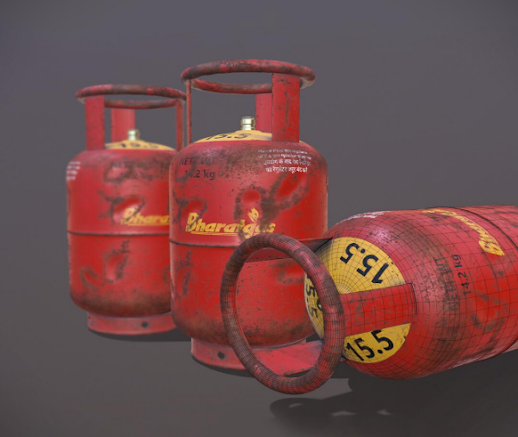How Do You Check for Gas Cylinder Leaks
In Bangladesh, LPG cylinders are commonly used for cooking and water heating. When the gas used in the cylinder (Propane or Butane) leaks from faulty equipment, it is highly combustible and poses a risk. LPG appliances' gas regulators, hoses, seals, and other components might malfunction or wear down over time, resulting in severe gas leaks. Continue reading to learn more about gas leaks, how to prevent them, and what to do if your equipment does.
Faulty equipment is the most common cause of a gas leak in a home. Various components in gas
appliances regulate and guide the flow of gas to burners. Mechanical failures and leaks can be
caused by manufacturing faults, wear and tear, or the component being used past its rated lifespan.
Because it receives the most wear and tear at its joints, the hose (the tube that transports gas from
the cylinder to the burner) is generally the first to break. A gas leak might also be caused by a
blockage in the burner, broken gaskets, or malfunctioning regulators. During cooking or heating,
a leak can occur when unattended objects such as milk or water boil over and spill on the burner,
extinguishing the flame and allowing the gas to escape.
What Makes a Gas Leak Risky?
Gas leaks are extremely dangerous for two reasons:
Exploding Risk:
When LPG is mixed with air, even in little amounts, it is extremely combustible. If a source of
ignition is present, a gas leak inside a confined place such as a house is a perfect recipe for an
explosion. When it detonates, it generates a significant amount of heat, which can burn the flesh
and set items on fire. The shock wave, which is high-pressure hot air traveling through the home
and expanding outward, causes more damage. The eardrums and lungs can be damaged, and people
can be knocked off their feet as a result of this pressure wave. It has the potential to launch objects
into the air and blow out windows, causing additional harm. Burns, shattered bones, and shrapnel
injuries follow, with death in some cases. Explosions can also cause walls to fall, causing more
property damage and injuries.
Health Risk:
When inhaled in large amounts, the gas can obstruct the flow of oxygen, resulting in suffocation
and death from hypoxia. Dizziness, exhilaration, lack of coordination, and hallucinations are some
of the symptoms of gas inhalation. Long-term inhalation in the form of minor leaks on a daily basis
can cause nervous system damage, convulsions, depression, memory loss, mood changes, and
other issues. It also has the potential to harm the heart, lungs, and kidneys. The generation of very
dangerous carbon monoxide gas is a subsequent result of incorrect gas combustion and insufficient
ventilation. Carbon monoxide poisoning is extremely harmful and, in many cases, fatal since it is
not immediately apparent when inhaled. Dizziness, nausea, abdominal and chest pain, headaches,
and loss of consciousness are among symptoms of inhaling the gas. Suffocation and death are the
results of losing consciousness.
How to Inspect for Leakage in a Gas Cylinder?
The sulphurous smell of ethyl mercaptan is a telltale symptom of an LPG cylinder leak.
Because the gas in the cylinder is nonflammable, it is a foul combination when mixed with
LPG. Anyone who has ever used a gas stove is familiar with the fragrance.
A considerable volume of gas is released suddenly, resulting in a smoggy white cloud in
the area surrounding the leak. It is best not to stroll into this cloud since it's dangerous.
A minor break in the tube can usually be heard as a slight leaking noise or felt with your
fingers when you run your fingers over it. To be sure, close the cylinder's regulator valve
and observe if the leak stops.
There's a simple way to identify LPG gas leaking if you have a gas line rather than a
cylinder. Turn off all of your gas-powered appliances. If the gas meter is still on, one of
your appliances is leaking gas.
How Can a Gas Leak Be Prevented?
Here are some pointers on how to keep your equipment in good working order and avoid a gas
leak:
The first step toward safety is to be aware. You and your family must be aware of the
warning signals of a gas leak as well as the contributing causes. Children, in particular,
should know how to spot a gas leak and take fast action to protect themselves.
If you're using gas burners in the kitchen or bathroom, be sure there's enough ventilation.
The equipment must be kept at a safe distance from the rest of the room, with appropriate
ventilation to allow fresh air to circulate.
Have your equipment tested by certified inspectors on a regular basis. Regulators, hoses,
and burners must all be inspected for wear and tear or faults. Similarly, get certified
equipment to ensure it isn't malfunctioning.
Install safety devices in the home, such as carbon monoxide detectors and fire
extinguishers. Carbon monoxide detectors resemble smoke detectors and sound an alarm
when the concentration of carbon monoxide reaches predetermined thresholds.
A gas explosion is dangerous and should be treated as such. It's critical to recognize the warning
symptoms early on so that the proper course of action can be taken to avert a disaster. A gas leak
can be avoided with basic safety procedures and regular equipment checks.





Comments
Post a Comment